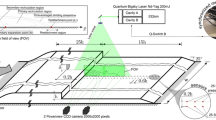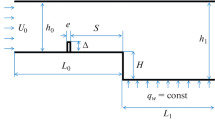Abstract
To date, a backflow phenomenon that occurs in subsonic zero-pressure-gradient and adverse-pressure-gradient turbulent boundary layers has been well studied and its existence in such flow types is beyond doubt. In the present investigation, focusing on a turbulent air flow in a duct with adjustable cross section, for the first time we provide experimental evidence for the existence of backflow events in a converging channel and demonstrate the possibility of their occurrence in a favorable-pressure-gradient turbulent boundary layer. Taking into account that the backflow events are characterized by the low probability of their occurrence and spatio-temporal extent at the level of the Kolmogorov scale, we pay special attention to the use of high-speed particle image velocimetry with high spatio-temporal resolution. The measurement results revealed a general tendency in the backflow formation mechanism in the considered flow regimes and channel configurations. In conjunction with the findings of other studies, we suggest that the backflow events are induced by transversely oriented vortices located in the buffer region of the turbulent boundary layer and formed as a result of the interaction of large-scale high-momentum and low-momentum flow regions.








Similar content being viewed by others
Data availability
The dataset obtained during the current study is not publicly available but are available from the corresponding author on reasonable request.
References
Adrian RJ, Meinhart CD, Tomkins CD (2000) Vortex organization in the outer region of the turbulent boundary layer. J Fluid Mech 422:1–54. https://doi.org/10.1017/S0022112000001580
Balachandar S, Eaton JK (2010) Turbulent dispersed multiphase flow. Annu Rev Fluid Mech 42:11–133. https://doi.org/10.1146/annurev.fluid.010908.165243
Brücker C (2015) Evidence of rare backflow and skin-friction critical points in near-wall turbulence using micropillar imaging. Phys Fluids 27:031705. https://doi.org/10.1063/1.4916768
Bross M, Fuchs T, Kähler CJ (2018) Analysis of an adverse pressure gradient turbulent boundary layer with 2d- and 3d-time-resolved particle tracking. In: 5th International Conference on Experimental Fluid Mechanics ICEFM 2018 Lisbon, Portugal
Bross M, Fuchs T, Kähler CJ (2019) Interaction of coherent flow structures in adverse pressure gradient turbulent boundary layers. J Fluid Mech 873:287–321. https://doi.org/10.1017/jfm.2019.408
Cardesa JI, Monty JP, Soria J, Chong MS (2014) Skin-friction critical points in wall-bounded flows. J Phys Conf Ser 506(1):012009. https://doi.org/10.1088/1742-6596/506/1/012009
Cardesa JI, Monty JP, Soria J, Chong MS (2019) The structure and dynamics of backflow in turbulent channels. J Fluid Mech. https://doi.org/10.1017/jfm.2019.774
Chang PK (1976) Control of flow separation: energy conservation, operational efficiency, and safety. NASA STI/Recon Tech Rep A 77:11232
Chin RC, Monty J, Chong MS, Marusic I (2018) Conditionally averaged flow topology about a critical point pair in the skin friction field of pipe flows using direct numerical simulations. Phys Rev Fluids 3:114607. https://doi.org/10.1103/PhysRevFluids.3.114607
Chin RC, Vinuesa R, Orlu R et al (2020) Backflow events under the effect of secondary flow of Prandtl’ first kind. Phys Rev Fluids 5:074606. https://doi.org/10.1103/PhysRevFluids.5.074606
Chong MS, Monty JP, Chin C, Marusic I (2012) The topology of skin friction and surface vorticity fields in wall-bounded flows. J Turbul 21:N6. https://doi.org/10.1080/14685248.2012.663093
Colella KJ, Keith WL (2003) Measurements and scaling of wall shear stress fluctuations. Exp Fluids 34:253–260. https://doi.org/10.1007/s00348-002-0552-2
Daly BJ, Harlow FH (1970) Transport equations in turbulence. Phys Fluids 13(11):2634–2649. https://doi.org/10.1063/1.1692845
Diaz-Daniel C, Laizet S, Vassilicos JC (2017) Twall shear stress fluctuations: mixed scaling and their effects on velocity fluctuations in a turbulent boundary layer. Phys Fluids 29:055102. https://doi.org/10.1063/1.4984002
Eckelmann H (1974) The structure of the viscous sublayer and the adjacent wall region in a turbulent channel flow. J Fluid Mech 65:439–459
Gibson M, Launder B (1978) Ground effects on pressure fluctuations in the atmospheric boundary layer. J Fluid Mech 86(3):491–511. https://doi.org/10.1017/S0022112078001251
Guerrero B, Lambert RC, Chin MF (2020) Extreme wall shear stress events in turbulent pipe flows: spatial characteristics of coherent motions. J Fluid Mech 904:A18. https://doi.org/10.1017/jfm.2020.689
Hu Z, Morfey CL, Sandham ND (2006) Wall pressure and shear stress spectra from direct simulations of channel flow. AIAA J 44:1541–1549. https://doi.org/10.2514/1.17638
Jalalabadi R, Sung HJ (2018) Influence of backflow on skin friction in turbulent pipe flow. Phys Fluids 30:065104. https://doi.org/10.1063/1.5026998
Kähler CJ, Astarita T, Vlachos PP et al (2016) Main results of the 4th international piv challenge. Exp Fluids 57:97. https://doi.org/10.1007/s00348-016-2173-1
Launder BE, Reece GJ, Rodi W (1975) Progress in the development of a Reynolds-stress turbulence closure. J Fluid Mech 68(3):537–566. https://doi.org/10.1017/S0022112075001814
Lenaers P, Li Q, Brethouwer G, Schlatter R, Orlu P (2012) Rare backflow and extreme wall-normal velocity fluctuations in near-wall turbulence. Phys Fluids 24:035110. https://doi.org/10.1063/1.3696304
Liu Y, Klaas M, Schröder W (2019) Measurements of the wall-shear stress distribution in turbulent channel flow using the micro-pillar shear stress sensor mps3. Exp Therm Fluid Sci 106:171–182. https://doi.org/10.1016/j.expthermflusci.2019.04.022
Örlü R, Vinuesa R (2020) Instantaneous wall-shear-stress measurements: advances and application to near-wall extreme events. Meas Sci Technol 31:112001. https://doi.org/10.1088/1361-6501/aba06f
Pan C, Kwon Y (2018) Extremely high wall-shear stress events in a turbulent boundary layer. J Phys Conf Ser 1001:012004. https://doi.org/10.1088/1742-6596/1001/1/012004
Raffel M, Willert CE, Scarano F et al (2018) Particle image velocimetry. Springer, Cham
Robinson SK (1991) The kinematics of turbulent boundary layer structure. NASA Tech Memo 103859:479
Schlatter P, Orlu R (2010) Assessment of direct numerical simulation data of turbulent boundary layers. J Fluid Mech 659:116–126. https://doi.org/10.1017/S0022112010003113
Simpson RL (1989) Turbulent boundary-layer separation. Annu Rev Fluid Mech 21:205–232. https://doi.org/10.1146/annurev.fl.21.010189.001225
Smith CR, Walker JDA, Haidari AH, Sobrun U (1991) On the dynamics of near-wall turbulence. Philos Trans R Soc Lond Ser A Phys Eng Sci 336:131–175. https://doi.org/10.1098/rsta.1991.0070
Spalart P, Coleman G (1997) Numerical study of a separation bubble with heat transfer. Eur J Mech B Fluids 16:169–189
Stanislas M, Okamoto K, Kähler C (2003) Main results of the first international piv challenge. Meas Sci Technol 14:R63–R89. https://doi.org/10.1088/0957-0233/14/10/201
Stanislas M, Okamoto K, Kähler CJ et al (2008) Main results of the third international piv challenge. Exp Fluids 45:27–71. https://doi.org/10.1007/s00348-008-0462-z
Stanislas M, Okamoto K, Kähler CJ, Westerweel J (2005) Main results of the second international piv challenge. Exp Fluids 39:170–191. https://doi.org/10.1007/s00348-005-0951-2
Tardu S (2017) Near wall dissipation revisited. Int J Heat Fluid Flow 67:104–115. https://doi.org/10.1016/j.ijheatfluidflow.2017.03.006
http://www.openfoam.com (2004) Project site OpenFOAM
Vinuesa R, Orlu R, Schlatter P (2017) Characterisation of backflow events over a wing section. J Turbul 18:170–185. https://doi.org/10.1080/14685248.2016.1259626
Willert CE, Cuvier C, Foucaut JM et al (2018) Experimental evidence of near-wall reverse flow events in a zero pressure gradient turbulent boundary layer. Exp Therm Fluid Sci 91:320–328. https://doi.org/10.1016/j.expthermflusci.2017.10.033
Wu X, Cruickshank M, Ghaemi S (2020) Negative skin friction during transition in a zero-pressure-gradient flat-plate boundary layer and in pipe flows with slip and no-slip boundary conditions. J Fluid Mech 887:A26. https://doi.org/10.1017/jfm.2020.17
Yao YC, Huang WX, Xu CX (2018) Amplitude modulation and extreme events in turbulent channel flow. Acta Mech Sin 34:1–9. https://doi.org/10.1007/s10409-017-0687-2
Zaripov D, Ivashchenko V, Mullyadzhanov R et al (2021) Reverse flow phenomenon in duct corners at a low Reynolds number. Phys Fluids 33:085130. https://doi.org/10.1063/5.0055859
Zaripov D, Li R, Dushin N (2019) Dissipation rate estimation in the turbulent boundary layer using high-speed planar particle image velocimetry. Exp Fluids 60:18. https://doi.org/10.1007/s00348-018-2663-4
Zaripov D, Li R, Saushin I (2020) Extreme events of turbulent kinetic energy production and dissipation in turbulent channel flow: particle image velocimetry measurements. J Turbul 21:39–51. https://doi.org/10.1080/14685248.2020.1727914
Zaripov DI (2021) Problems of an experimental study of a reverse flow in the turbulent channel flow. J Phys Conf Ser 2057:012097. https://doi.org/10.1088/1742-6596/2057/1/012097
Zaripov D, Ivashchenko V, Mullyadzhanov R et al (2021) On a mechanism of near-wall reverse flow formation in a turbulent duct flow. J Fluid Mech 923:A20. https://doi.org/10.1017/jfm.2021.526
Acknowledgements
Not applicable.
Funding
Numerical simulations and data analysis were supported by the Ministry of Science and Higher Education of the Russian Federation (agreement No. 075-15-2020-806). Experiments were conducted within the Russian Science Foundation grant no. 22-19-00507.
Author information
Authors and Affiliations
Contributions
D.Z. and A.S. designed the test section of the experimental setup and carried out the experiments. D.Z. and A.L. processed all the experimental results and discovered the backflow phenomenon in a converging channel. E.I. and R.M. performed RANS simulations. Analysis and interpretation of the results were carried out by D.Z., R.L. and D.M. D.Z. wrote an original draft of the manuscript. All authors reviewed the manuscript.
Corresponding authors
Ethics declarations
Conflict of interest
The authors have no relevant financial or non-financial interests to disclose.
Ethics approval and consent to participate
Not applicable.
Consent for publication
The authors verbally consented to publish the results.
Additional information
Publisher's Note
Springer Nature remains neutral with regard to jurisdictional claims in published maps and institutional affiliations.
Rights and permissions
Springer Nature or its licensor (e.g. a society or other partner) holds exclusive rights to this article under a publishing agreement with the author(s) or other rightsholder(s); author self-archiving of the accepted manuscript version of this article is solely governed by the terms of such publishing agreement and applicable law.
About this article
Cite this article
Zaripov, D., Li, R., Lukyanov, A. et al. Backflow phenomenon in converging and diverging channels. Exp Fluids 64, 9 (2023). https://doi.org/10.1007/s00348-022-03536-0
Received:
Revised:
Accepted:
Published:
DOI: https://doi.org/10.1007/s00348-022-03536-0




